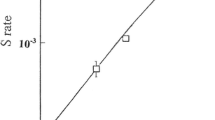Summary
-
1.
The inheritance of antigens which produce immobilizing antibodies has been studied inParamecium aurelia, variety 2. A single gene can control the ability to manifest an antigen. The appearance of one of two alternative cross-reactive antigens is also controlled by a single factor. The stability and titres of theF 1 clones of a cross between two homologous serotypes and the variation in the appearance of the serotype of such genotypically identical clones were examined.
-
2.
The cytoplasm has an influence on the appearance of the immobilizing antigens in exconjugants of crosses between animals of similar serotypes and, especially, diverse serotypes. The influence of the parental serotype in crosses between cross-reacting serotypes may persist for as long as twenty postconjugation fissions, but in the majority of instances disappears within a few fissions. In contrast, when paramenia of the same genotypes but diverse serotypes are crossed, the parental serotype may persist indefinitely.
-
3.
The persistence of a hybrid phenotype inF 2 generation animals presumed to be homozygous is probably due to nuclear abnormalities which ensure the maintenance of a heterozygous genotype, rather than to the action of cytoplasmic particles.
Similar content being viewed by others
References
Beale, G. H. (1952). Antigenic variation inP. aurelia, variety 1.Genetics,37, 62.
Beale, G. H. (1954).The Genetics of Paramecium aurelia. Cambridge University Press.
Diller, W. F. (1936). Nuclear reorganization processes inParamecium aurelia with descriptions of autogamy and ‘hemixis’.J. Morphol. 59, 11.
Dippell. R. V. (1955). Some cytological aspects of aging in variety 4 ofParamecium aurelia.J. Protozoal. 2. Suppl.
Dippell, R. V. (1956). A preliminary report on the chromosomal constitution of certain variety 4 races ofParamecium aurelia.Proc. Ninth Int. Congr. Genetics, pt. II (in the Press).
Fisher, R. A. (1947). The rhesus factor. A study in scientific method.Amer. Sci. 35, 95.
Irwin, M. R. (1951).Genetics and Immunology in Genetics in the 20th Century. New York: Macmillan.
Kimball, R. F. &Gaither, N. (1955). Behaviour of nuclei at conjugation inParamecium aurelia. I. Effect of incomplete chromosome sets and competition between complete and incomplete nuclei.Genetics,6, 878.
Sonneborn, T. M. (1946). Inert nuclei: inactivity of micronuclear genes in variety 4 ofParamecium aurelia.Genetics,31, 231.
Sonneborn, T. M. (1948). The determination of hereditary antigenic differences in genically identicalParamecium cells.Proc. Nat. Acad. Sci., Wash.,34, 413.
Sonneborn, T. M. (1950a). Methods in the general biology and genetics ofP. aurelia.J. Exp. Zool. 113, 87.
Sonneborn, T. M. (1950b). The cytoplasm in heredity.Heredity,4, 11.
Sonneborn, T. M. (1954). Problems of tumors in relation to studies onParamecium.Proc. Second Nat. Cancer Conf. 2, 1139.
Sonneborn, T. M. &Balbinder, E. (1953). The effect of temperature on the expression of allelic genes for serotypes in a heterozygote ofParamecium aurelia.Microbiol. Gen. Bull. 7, 2–1.
Sonneborn, T. M. &LeSuer, A. (1948). Antigenic characters inP. aurelia (variety 4): determination, inheritance and induced, mutations.Amer. Nat. 82, 69.
Sonneborn, T. M., Ogasawara &Balbinder, E. (1953). The temperature sequence of the antigenic types in variety 4 ofParamecium aurelia in relation to the stability and transformations of antigemc types.Microbiol. Gen. Bull. 7, 27.
Sonneborn, T. M. &Schneller, M. (1955). The basis of aging in variety 4 ofParamecium aurelia.J. Protozool. 2, Suppl.
Author information
Authors and Affiliations
Additional information
Submitted in partial fulfilment of the requirements for the Ph.D. Degree of the University of Pennsylvania.
Rights and permissions
About this article
Cite this article
Finger, I. The inheritance of the immobilization antigens ofParamecium Aurelia, variety 2. J Genet 55, 361–374 (1957). https://doi.org/10.1007/BF02981649
Received:
Issue Date:
DOI: https://doi.org/10.1007/BF02981649




